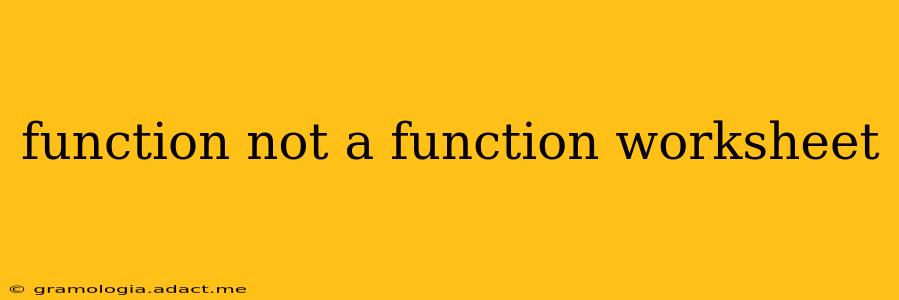Determining whether a relationship represents a function is a fundamental concept in algebra. This worksheet will guide you through various methods to identify functions, addressing common misconceptions and building a strong understanding of the topic. We'll explore different representations of relationships – tables, graphs, mappings, and equations – and learn how to determine if they satisfy the definition of a function.
What is a Function?
A function is a relationship where each input (x-value) has only one unique output (y-value). Think of it like a machine: you put in an input, and it gives you only one specific output. If you put in the same input and get multiple outputs, it's not a function.
Identifying Functions from Different Representations
Let's explore how to identify functions from different representations:
1. Tables of Values
Example:
| Input (x) | Output (y) |
|---|---|
| 1 | 2 |
| 2 | 4 |
| 3 | 6 |
| 4 | 8 |
Is this a function? Yes. Each x-value has only one corresponding y-value.
Example:
| Input (x) | Output (y) |
|---|---|
| 1 | 2 |
| 2 | 4 |
| 3 | 6 |
| 3 | 8 |
Is this a function? No. The input x = 3 has two different outputs (6 and 8).
To identify if a table represents a function, check if any x-value is repeated with different y-values.
2. Graphs
The Vertical Line Test is a powerful tool for determining if a graph represents a function.
Vertical Line Test: If a vertical line intersects the graph at more than one point, the graph does not represent a function.
Example: A parabola that opens upwards (like y = x²) passes the vertical line test and is a function.
Example: A circle fails the vertical line test; a vertical line can intersect it at two points, so it's not a function.
3. Mappings (or Diagrams)
Mappings visually represent the relationship between inputs and outputs. If any input has multiple arrows pointing to different outputs, it's not a function.
Example: A mapping where the input set {1, 2, 3} maps to the output set {4, 5, 6} with each input having only one arrow, represents a function.
Example: If input '1' maps to both '4' and '7', then it is not a function.
4. Equations
Equations can also represent functions. To determine if an equation is a function, you can often solve for 'y'. If you can get a single solution for 'y' for every 'x', the equation represents a function. If you get multiple solutions for 'y' for a single 'x', it's not a function.
Example: y = 2x + 1 is a function because for every value of x, there's only one value of y.
Example: x² + y² = 4 (a circle) is not a function, as solving for y would result in two solutions (a positive and negative square root).
Frequently Asked Questions (FAQs)
How can I tell if a relation is a function using a graph?
Use the vertical line test. If any vertical line intersects the graph more than once, it's not a function.
What if an equation has both x and y squared?
It's likely not a function. Squaring terms often leads to multiple solutions for y given a single x. The vertical line test on its graph would confirm this.
Is it possible for a function to have the same output for different inputs?
Absolutely! A function can have multiple inputs mapping to the same output. The key is that each input has only one output.
Can I use a graphing calculator to help me?
Yes! Graphing calculators can plot equations and allow you to visually apply the vertical line test.
Are all equations functions?
No. Many equations do not represent functions.
This worksheet provides a comprehensive overview of how to determine if a relation is a function. Remember the key rule: one input, one output! Practice with different examples to solidify your understanding. By mastering this concept, you'll be well-prepared for more advanced topics in algebra and beyond.
